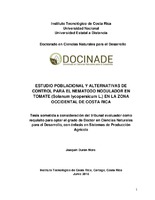Estudio poblacional y alternativas de control para el nematodo nodulador en tomate (solanum lycopersicum l.) en la zona occidental de Costa Rica
Resumen
Between 2012 and 2015, the natural extracts of hot pepper (Capsicum annun), queen of the night (Brugmansia), vegetal extract formulated of flower of dead (Tagetes patula) (80 SL), a commercial product based on marine algae and nucleic acids (0.55 SL), and the conventional chemical (Oxamyl 24 SL), with the purpose of determining its nematicidal effects on Meloidogyne spp. in tomato (Solanum lycopersicum L.) variety JR. The research was conducted in commercial farms, in greenhouses and laboratories, in the western zone of Costa Rica. The investigations carried out in the field were in tomato (Solanum lycopersicum L.) plantations in association with coffee (Coffea arabiga, Caturra). In the greenhouse two alternating sowings were carried out, by means of a random design with trifactorial arrangement, tomato seedlings were inoculated with 100 Juveniles (J2) and Meloidogyne eggs, and later they were treated with the afore mentioned extracts, in addition to the conventional chemical and a absolute treatment (water). In this greenhouse stage, samplings were made in the first sowing (43, 65, 119 and 138 days after transplanting (DAT), and the second planting (33, 69, 88 and 115 DAT). In both sowings the variables: weight aerial part of the plant, weight roots, final harvest weights, percentage of galling and population of phytoparasitic nematodes were measured. In the laboratory, Meloidgyne's J2 were exposed in contact with natural extracts to quantify mortality at 24, 48 and 72 hours after inoculated treatments (hait).
In tomato plantations in association with coffee, the nodular nematodes Meloidogyne, the lesion nematode Pratylenchus, and the spiral nematode Helicotylenchus were identified in greater quantity, and in smaller amounts Criconemoides and Aphelenchoides. The levels of galls in the tomato plots associated with coffee were 90%, while in the monoculture tomato areas there were no galls.
In the greenhouse, the main genera that were identified and quantified were Meloidogyne, Pratylenchus, Helicotylenchus. At the end of the first sowing, the
19
treatments that showed the lowest Meloidogyne populations in the soil were the commercial chemical control (both doses), and the extracts of the queen of the night (50 ppm), and hot pepper (100 ppm and 50 ppm). In roots, the extract of tagetes (both doses), and queen of the night (50 ppm), presented lower populations of Meloidogyne. Fresh weights of higher roots at the time of the final harvest were presented by hot pepper, and the conventional chemical (both doses).
In the second sowing, the levels of the lowest populations in soil were obtained with the conventional chemical (15 cc/liter) and hot pepper (100 ppm). At 88 DAT, treatments with lower doses (conventional chemical, hot pepper and seaweed extract), presented the highest root weights, while in leaves (115 DAT), the tagetes and hot pepper (high doses) treatments, they presented higher fresh weights. The populations obtained from Meloidogyne in the research were much higher than the action threshold determined by Talavera (2003).
Under in vitro conditions, the extract of tagetes and the conventional chemical (50 ppm), presented the highest mortalities of Meloidogyne individuals, while the algae extract presented the lowest mortality (10.6%). In a dose of 100 ppm, the conventional chemical showed the total mortality of the individuals during the 3 evaluations, followed by the extracts of tagetes (60.3%) and queen of the night (44.2%).
These results show the extracts of tagetes, hot pepper and queen of the night as options for the alternative phytosanitary management of nematodes in tomato.
Descripción
Tesis (Doctor en Ciencias Naturales para el Desarrollo, con énfasis en Sistemas de Producción Agrícola). Instituto Tecnológico de Costa Rica. Universidad Nacional. Universidad Estatal a Distancia, Doctorado en Ciencias Naturales para el Desarrollo, 2018.


